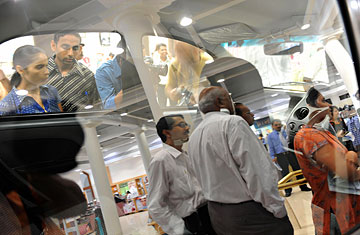
Visitors inspect the world's cheapest car at a Tata retail showroom in Mumbai on April 1, 2009
Strong initial orders for Tata Motors' new ultra-cheap car, the Nano, have boosted the struggling Indian carmaker's finances while prompting competitors to launch their own low-cost models. (Read "The World's Cheapest Car Debuts in India.")
Six weeks after the $2,000 Nano formally debuted in Mumbai, Tata Motors announced this week that it had taken pre-paid orders for 203,000 vehicles during a special 16-day booking period that ended April 25. Dilip Chenoy, director general of the Society of Indian Automobile Manufacturers (SIAM), says the Nano is the first car in India to log more than 200,000 orders at launch. In comparison, the tiny Suzuki Alto, one of the Japanese carmaker's best-selling Indian offerings, has sold 913,000 units in the domestic market since 2000. (See the 10 things you should know about the Nano.)
Tata Motors' unusual sales scheme for the Nano could ease some of its financial pressures related to $3 billion in short-term debt taken on by the company to acquire Jaguar and Land Rover from Ford in March 2008. Because buyers placing orders for Nanos were required to pay for their cars in full, Tata Motors — India's largest car company — is receiving a $507 million cash infusion. Analysts say the revenue will reduce the company's liquidity problems and make it easier to refinance its outstanding loans, which come due next month. Tata Motors repaid $1 billion of the debt through a rights issue in October 2008.
Delivery of Nanos will begin in July, but because of manufacturing constraints, tens of thousands of buyers could have to wait more than a year before their cars are built. The company has committed to producing cars for the first 100,000 owners, who will be selected through a lottery, by the end of 2010. The rest of the buyers are on indefinite hold. They can cancel their bookings and get their money back. Those who choose to stay in line will be paid interest on their deposits by Tata Motors while they wait.
They could be waiting a long time. Initial Nano production is taking place at a retooled truck plant in Pantnagar in northern India. Tata does not expect to open its dedicated Nano factor — a facility that will be able to churn out 250,000 cars a year that is now under construction in Gujarat on India's west coast — until next year. "Tata Motors will take at least two to three years to get to full capacity," says Darius Lam, associate editor for AutoCar Professional. "Ramping up is a slow process."
The Nano shortage notwithstanding, Tata Motors has demonstrated there is a market for the low-priced car, which has four doors and a 33-horsepower, 634cc engine located in the rear, Volkswagen Beetle style. "The Nano has shown how a new product at the right price can change the rules of the game," says SIAM's Chenoy.
Other automakers are reacting. Suzuki India this week announced plans to launch a 660cc car for the domestic market but did not divulge the car's price. Renault, Toyota and Hyundai are also developing small cars for the low end of the Indian market, now defined by the Nano. Volkswagen is believed to have plans for a two-door, rear-engine car. "The Nano has opened a big market segment, and all the players will certainly push up their launches to attract those buyers fast," says Lam.
Read "India's Top Automaker, Tata Motors, Hits a Rough Patch."
